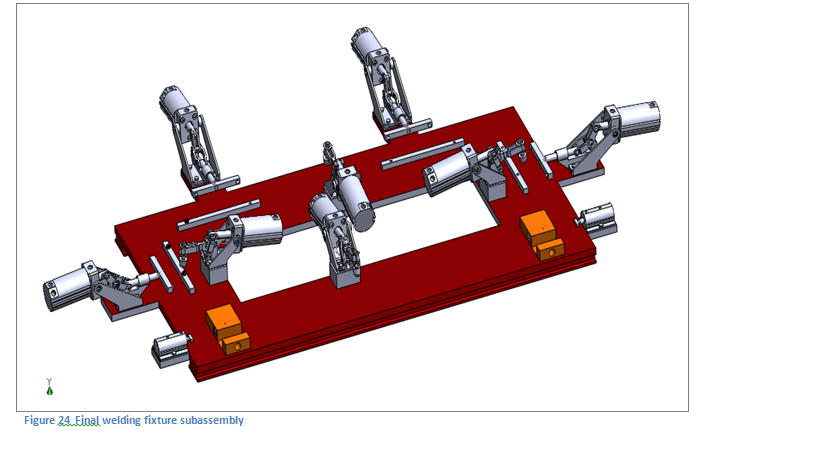DESIGN OF JIG AND FIXTURE FOR MILLING MACHINE
Case study : Milling machine Cylindrical parts
INTRODUCTION
Over the past century, manufacturing has made considerable progress. New machine tools, high-performance cutting tools, and modern manufacturing processes enable today’s industries to make parts faster and better than ever before. Although work holding methods have also advanced considerably, the basic principles of clamping and locating are still the same. Mass production methods demand a fast and easy method of positioning work for accurate operations on it. Jigs and fixtures are production tools used to accurately manufacture duplicate and interchangeable parts. Jigs and fixtures are specially designed so that large numbers of components can be machined or assembled identically, and to ensure interchangeability of components.
The economical production of engineering components is greatly facilitated by the provision of jigs and fixtures. The use of a jig or fixture makes a fairly simple operation out of one which would otherwise require a lot of skill and time. Both jigs and fixtures position components accurately; and hold components rigid and prevent movement during working in order to impart greater productivity and part accuracy. Jigs and fixtures hold or grip a work piece in the predetermined manner of firmness and location, to perform on the work piece a manufacturing operation.

Objectives
The objectives for this project are:
1. To identify the locating, supporting and clamping methods and details to suit specific jig and fixture for milling machine cylindrical parts.
2.To calculate and analyze the clamp to hold tile cylindrical work piece for this jig and fixture.
3. To design template jig and fixture for milling machines cylindrical parts.
4. To generate a new cylindrical work piece result by using the machining processes in milling machine.
5. To change the type of work piece used for milling machine.
6. To construct a new jig and fixture product for milling machine.
JIGS
A jig is a special device that holds, supports, or is placed on a part to be machined. It is a production tool made so that it not only locates and holds the workpiece but also guides the cutting tool as the operation is performed. Jigs are usually fitted with hardened steel bushings for guiding drills or other cutting tools.
A jig is any of a large class of tools in woodworking, metalworking, and some other crafts that help to control the location or motion (or both) of a tool. Some types of jigs are also called templates or guides. The primary purpose for a jig is for repeatability and exact duplication of a part for reproduction. An example of a jig is when a key is duplicated, the original is used as a jig so the new key can have the same path as the old one. Since the advent of automation and CNC machines, jigs are often not required because the tool path is digitally programmed and stored in memory.
The most-common jigs are drill and boring jigs. These tools are fundamentally the same. The difference lies in the size, type, and placement of the drill bushings. Boring jigs usually have larger bushings. These bushings may also have internal oil grooves to keep the boring bar lubricated. Often, boring jigs use more than one bushing to support the boring bar throughout the machining cycle.
Jig that expedites repetitive hole center location on multiple interchangeable parts by acting as a template to guide the twist drill or other boring device into the precise location of each intended hole center. In metalworking practice, typically a hardened bushing lines each hole on the jig to keep the twist drill from cutting the jig.
FIXTURES
A fixture is a device for locating, holding and supporting a workpiece during a manufacturing operation. It is a production tool that locates, holds, and supports the work securely so the required machining operations can be performed.
Fixtures have a much-wider scope of application than jigs. These workholders are designed for applications where the cutting tools cannot be guided as easily as a drill. With fixtures, an edge finder, center finder, or gage blocks position the cutter. Examples of the more-common fixtures include milling fixtures, lathe fixtures, sawing fixtures, and grinding fixtures. Moreover, a fixture can be used in almost any operation that requires a precise relationship in the position of a tool to a workpiece.
Fixtures are essential elements of production processes as they are required in most of the automated manufacturing, inspection, and assembly operations. Fixtures must correctly locate a workpiece in a given orientation with respect to a cutting tool or measuring device, or with respect to another component, as for instance in assembly or welding. Such location must be invariant in the sense that the devices must clamp and secure the workpiece in that location for the particular processing operation. There are many standard work holding devices such as jaw chucks, machine vises, drill chucks, collets, etc. which are widely used in workshops and are usually kept in stock for general
applications.
Basic Design Steps
1. Method of locating the part – identify the standard components required for locating Purpose.
2. Design the clamping method. Make a proper choice of clamps – C-washer, swing
washer, nut, strap clamp, toggle clamp, etc.
3. Design any supports required
4. Design the jig bushes required.
5. Design the jig body.
Basic Design Drill Jig
1. Method of locating the part – The central hole which helps in locating as well as indexing for the hole.
2. Clamping can be done with a nut and a C-washer
Indexing will have to be done with a plunger type retracting.










Post Comment
You must be logged in to post a comment.